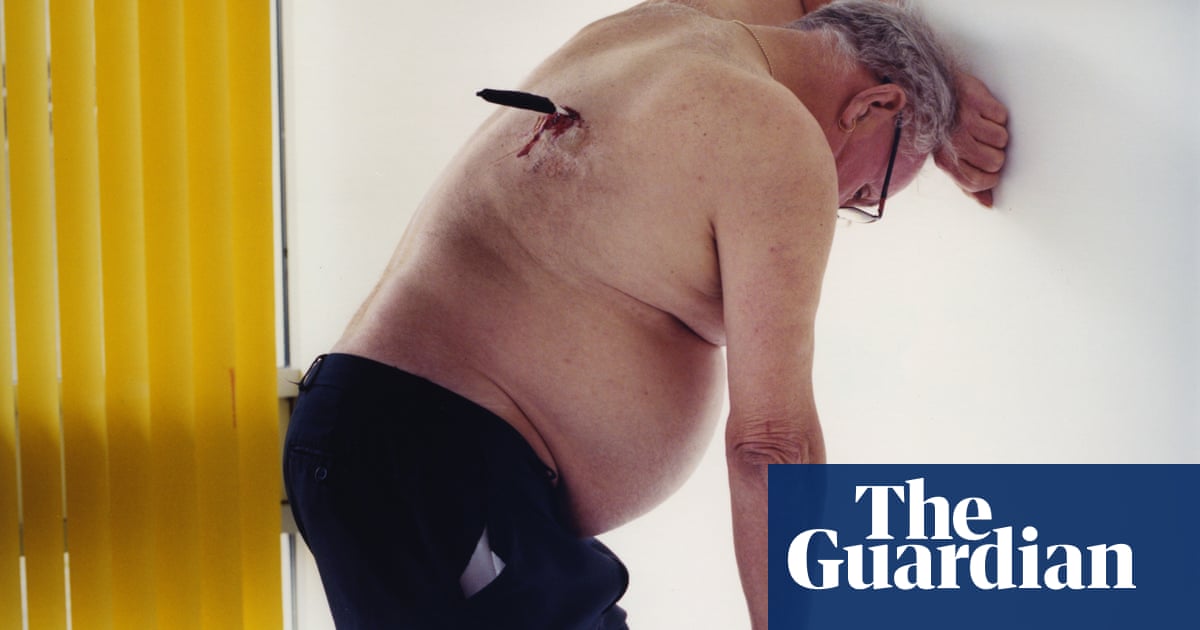
In September 1976 I was 24, and working as photographer-in-residence for the borough of Pendle in Lancashire. One of the extended pieces of work I did there was about industrial decline. A few months into the project I met Stanley Graham, an engineer at a steam-powered cotton mill in Barnoldswick, who introduced me to all sorts of interesting people, including steeplejack Peter Tatham.
When I heard Peter was about to start work dismantling a disused incinerator chimney in Salford, I was determined to document the job. I was fascinated by the complex, almost balletic way he lashed a succession of 15ft ladders up the side of the towering stack, chiselling holes, banging in wedges and attaching metal hooks called “dogs”. Knowing I’d soon be testing myself on those ladders, I studied his climbing and resting techniques closely.
The chimney was in a built-up area next to the River Irwell, so it had to be broken up piecemeal from the top down. The first time I climbed all the way up, Peter insisted on going first. “That way,” he said, “if you fall, you won’t knock me off.” There’s a big difference between climbing a ladder that’s leaning against a wall and one that’s vertical, and in this case there were a dozen of them, going straight up for 160ft (50 metres). There was no harness and I was acutely aware of gravity pulling at my back.
Peter was in his 40s and a heavy smoker but he was stocky, strong, confident and soon way ahead of me. Despite my relative youth, I had little strength in my arms and my six-and-a-half foot frame means I’m not a natural climber. I tried to concentrate on the brickwork scrolling in front of my nose rather than the ever-dwindling ground and experienced a mixture of terror and exhilaration as I recalled something else Peter had said: “If you fall off two ladders you’re as dead as if you fall off 12.”
At the top of ladder number 10, I was directly beneath the oversiller, the chimney’s cast iron cap – it was like looking up at the brim of a hat. The next ladder leaned out at a sharp angle, meaning I’d be taking my weight in my arms, hanging perilously above the drop. Perhaps sensing my weakening resolve, Peter reached over the brim to grab my forearm. Moments later, I was sitting astride the circle of wall at the very top, one leg dangling into the void of the stack, the other outside in the world.
Even in a light breeze a chimney will sway and I watched the horizon tilting slowly, first one way, then the other. I still get the heebie-jeebies recalling Peter and his two labourers breaking up the very structure we were sitting on, drilling holes in the cast iron and splitting it with car jacks, lump hammers and cold chisels. Though Peter’s work demonstrated great skill, he always seemed wonderfully relaxed. That’s how he comes across in this photograph, taken on the second time out of three I climbed the chimney. By then Peter and the boys were working their way round knocking out the brickwork and dropping it straight down the shaft. They’d made a hole at the base so the rubble spilled out into a waiting skip.
I got this shot while Peter was resting, hammer in hand. I’d borrowed an ultra wide-angle lens and, as there was very little space, I’d stepped back on to the ladder. I needed both hands, so one of Peter’s labourers, Ziggy, held on to me. You can see his right hand holding a roll-up. What you can’t see is that his left hand – the one I was relying on – was in a plaster cast.
I got the impression Peter enjoyed the fact I’d captured him looking so nonchalant, and when a spread of the steeplejack pictures appeared in Lancashire Life magazine, he was tickled at the thought people would see pictures of him while sitting in dentists’ waiting rooms. It felt important that people like Peter gained some recognition for the extraordinary work they did. I felt an enormous sense of privilege too, at being allowed entry to this secret world. He needn’t have risked letting me climb up that chimney but he decided to trust me and that still means the world.
Daniel Meadows’s CV
Born: Gloucestershire, 1952.
Trained: Manchester Polytechnic.
Influences: Bill Brandt, Bill Jay, David Hurn.
High point: “In 2019, the archive of my life’s work was acquired by the Bodleian Library at the University of Oxford.”
Low point: “In 2012 I was diagnosed with multiple sclerosis.”
Top tip: “Make it a daily habit to engage with strangers.”
Facing Britain, an exhibition of British documentary photography that includes works by Daniel Meadows, is at the Mönchehaus Museum, Goslar, Germany, until 1 May, and touring until 18 September. Daniel Meadows’ books Us and Them, England 1981-1985, and Eight Stories + One are available from Café Royal Books.












